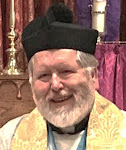 Pope Gregory the Great saw some fair-haired Anglo-Saxon slaves exposed for sale in a market in Rome. He asked where they were from, and when he was told, replied non Angli, sed angeli – “not Angles, but angels”, and determined to secure their evangelization.
Pope Gregory the Great saw some fair-haired Anglo-Saxon slaves exposed for sale in a market in Rome. He asked where they were from, and when he was told, replied non Angli, sed angeli – “not Angles, but angels”, and determined to secure their evangelization.Gregory organised a party of thirty monks to travel to south-eastern England and spread the Gospel there, and chose as their leader Augustine, prior of the monastery of St Andrew in Rome. They landed in 597, and were welcomed by the king of Kent, Ethelbert, who became a Christian along with many of his subjects. A second wave of missionaries arrived in 601. Augustine went to Arles, in France, where he was consecrated archbishop of the English, and then returned to Canterbury to set up his see. The mission prospered, and he founded two more sees, at London and at Rochester in Kent.
The evangelization of the country was planned in close agreement with Pope Gregory, and took care to respect existing traditions. Pagan temples and holy places were not to be destroyed, but to be converted to Christian use; and pagan feasts were to be superseded by Christian ones. This is consistent with the pattern of evangelization throughout the first millennium, which saw Christianity as a fulfilment of what went before, rather than a contradiction of it. Even in Rome itself, temples of Juno had a tendency to become churches dedicated to Our Lady.
In the far west of Britain, where British bishops had survived the pagan invasions – or where they had fled to escape them – Augustine was less successful in establishing his authority. Many traditions of the Celtic church differed from the Roman ones; it took several generations for the whole of Great Britain to become Christian and for the English and British liturgical traditions to be reconciled.
Augustine created the Dioceses of London and Rochester, consecrating bishops for the new sees. He died at Canterbury on 26 May 604 or 605.
It has long been fashionable to belittle St. Augustine.
"‘We cannot,’ says Bishop Creighton, ‘reckon him higher than a capable official of the Roman Church.’ High indeed must have been the Roman standard for capable officials. It is true that he had not the force of Boniface or the attractiveness of the Scottish saints, and his letters to Gregory seem to show a man somewhat distrustful of his own judgment. But it is more likely that his modern detractors are mistaken in their estimate of his character and abilities than Gregory. Deeds speak louder than words. A stranger, ignorant of the language of the country to which he was sent, he was only in England seven years, yet he founded three bishoprics which endure to this day, and laid foundations on which his successors have been content to build." (C.P.S. Clarke)
PRAYER
O Lord our God,
who by thy Son Jesus Christ didst call thine apostles
and send them forth to preach the Gospel to the nations:
We bless thy holy name for thy servant Augustine,
first Archbishop of Canterbury,
whose labours in propagating thy Church among the English people
we commemorate today;
and we pray that all whom thou dost call and send
may do thy will, and bide thy time,
and see thy glory;
through Jesus Christ our Lord,
who liveth and reigneth with thee,
in the unity of the Holy Ghost,
one God, for ever and ever. Amen

















0 comments:
Post a Comment